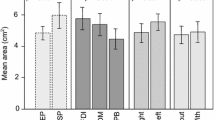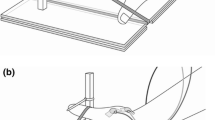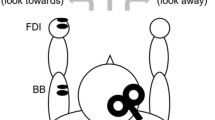Abstract
We sought to determine whether motor evoked potentials (MEPs) as well as silent periods could be produced in hand and shoulder muscles by transcranial magnetic stimulation (TMS) of the ipsilateral cerebral hemisphere and, if so, whether their cortical representations could be mapped with respect to those of contralateral muscles. In six normal subjects, we delivered ten stimuli each to a grid of sites 1 cm apart on the scalp. The EMG was recorded and averaged from the contralateral first dorsal interosseous (FDI) and risorius (facial) muscles at rest and the ipsilateral FDI muscle, which was voluntarily contracted. In four of these subjects and an additional subject, we used the same mapping technique and recorded from the deltoid muscle on the right and left sides and the contralateral FDI during activation of the ipsilateral deltoid. In all subjects, the cortical representation of the contralateral risorius was anterolateral to that of the FDI. The contralateral deltoid could be activated in only three subjects. In them, its representation was slightly medial to that of the FDI. All subjects had at least one scalp site where TMS produced MEPs in the ipsilateral FDI. Two subjects had rich ipsilateral hand representations with multiple ipsilateral MEP sites. Both had ipsilateral MEP sites near the representation of the contralateral FDI, but the largest ipsilateral MEPs occurred with TMS at more lateral sites, which were near the representation of the contralateral risorius. In these subjects, the ipsilateral deltoid was preferentially activated at sites medial and posterior to those activating the contralateral muscle. Ipsilateral TMS also produced silent periods in the FDI in all subjects. These silent periods were much more frequent than the ipsilateral MEPs and tended to occur with TMS near the representation of the contralateral FDI. The excitatory cortical representation of the ipsilateral arm muscles is accessible to TMS in normal subjects and is different from that of the homologous contralateral muscles. The hand may have two ipsilateral representations, one of which produces silent periods and the other MEPs at the same stimulus intensity.
Similar content being viewed by others
References
Aizawa H, Mushiake M, Tanji J (1990) An output zone of the monkey primary motor cortex specialized for bilateral hand movement. Exp Brain Res 82:219–221
Amassian VE, Cracco RQ (1987) Human cerebral cortical responses to contralateral transcranial stimulation. Neurosurgery 20:148–155
Amassian VE, Quirk GJ, Stewart M (1987) Magnetic coil versus electrical stimulation of monkey motor cortex. J Physiol (Lond) 394:119P
Benecke R, Meyer B-U, Freund H-J (1991) Reorganization of descending motor pathways in patients after hemispherectomy and severe hemispheric lesions demonstrated by magnetic brain stimulation. Exp Brain Res 83:419–426
Brodal A (1973) Self-observations and neuroanatomical considerations after a stroke. Brain 96:675–694
Bucy P, Fulton JF (1933) Ipsilateral representation in the motor and premotor cortex of monkeys. Brain 56:318–342
Cohen LG, Hallett M (1988) Noninvasive mapping of human motor cortex. Neurology 38:904–909
Cohen LG, Roth BJ, Nilsson J, Dang N, Panizza M, Bandinelli S, Friauf W, Hallett M (1990) Effects of coil design on delivery of focal magnetic stimulation. Technical considerations. Electroencephalogr Clin Neurophysiol 73:350–357
Cohen LG, Zeffiro T, Bookheimer S, Wassermann EM, Fuhr P, Matsumoto J, Toro C, Hallett M (1991) Reorganization in motor pathways following a large congenital hemispheric lesion: different motor representation areas for ipsi-and contralateral muscles. J Physiol (Lond) 438:33P
Colebatch JG, Gandevia SC (1989) The distribution of weakness in upper motor neuron lesions affecting the arm. Brain 112:749–763
Colebatch JG, Rothwell JC, Day BL, Thompson PD, Marsden CD (1990) Cortical outflow to proximal arm muscles in man. Brain 113:1843–1856
Davey NJ, Romaiguere P, Ellaway PH (1991) Inhibition of voluntary contraction by transcranial magnetic stimulation of the brain subthreshold for excitation in man. J Physiol (Lond) 446:447P
Di Piero V, Chollet FM, MacCarthy P, Lenzi GL, Frackowiack RSJ (1992) Motor recovery after acute ischaemic stroke: a metabolic study. J Neurol Neurosurg Psychiat 55:990–966
Edgley SA, Eyre JA, Lemon RN, Miller S (1990) Excitation of the corticospinal tract by electromagnetic and electrical stimulation of the scalp in the macaque monkey. J Physiol (Lond) 425:301–20
Ferbert A, Priori A, Rothwell JC, Day BL, Colebatch JG, Marsden CD (1992) Interhemispheric inhibition of the human motor cortex. J Physiol (Lond) 453:525–546
Fisher CM (1992) Concerning the mechanism of recovery in stroke hemiplegia. Can J Neurol Sci 19:57–63
Fries W, Danek A, Witt TN (1991) Motor responses after a transcranial electrical stimulation of cerebral hemispheres with a degenerated corticospinal tract. Ann Neurol 29:646–650
Holmgren H, Larsson LE, Pedersen S (1990) Late muscular responses to transcranial cortical stimulation in man. Electroencephalogr Clin Neurophysiol 75:161–172
Jones RD, Donaldson IM, Parkin PJ (1989) Impairment and recovery of ipsilateral sensory-motor function following unilateral cerebral infarction. Brain 112:113–132
Kuypers HGJM (1981) Anatomy of the descending pathways. In: J.M. Brookhart and V.B. Mountcastle (eds) Handbook of physiology, Section 1: The nervous system, vol. 2. Motor control, part 1. American Physiological Society, Bethesda MD, pp 597–666
Nathan PW, Smith MC, Deacon P (1990) The corticospinal tracts in man. Brain 113:303–324
Pascual-Leone A, Chugani HT, Cohen LG, Brasil-Neto JP, Valls-Solé J, Wassermann EM, Fuhr P, Hallett M (1992) Reorganization of human motor pathways following hemispherectomy. Ann Neurol 32:261
Pascual-Leone A, Houser CM, Reeves K, Shotland LI, Grafman J, Sato S, Valls-Solé J, Brasil-Neto JP, Wassermann EM, Cohen LG, Hallett M (1993) Safety of rapid-rate transcranial magnetic stimulation in normal volunteers. Electroencephalogr Clin Neurophysiol 89:120–130
Penfield W, Boldrey E (1937) Somatic motor and sensory representation in the cerebral cortex of man as studied by electrical stimulation. Brain 60:389–443
Ralston DD, Ralston HR (1985) The terminations of corticospinal tract axons in the macaque monkey. J Comp Neurol 242:325–337
Rothwell JC, Thompson PD, Day BL, Dick JPR, Kachi T, Cowan JMA, Marsden CD (1987) Motor cortex stimulation in intact man. 1. General characteristics of EMG responses in different muscles. Brain 110:1173–1190
Shibasaki H, Yamashita Y, Kuroiwa Y (1978) Electroencephalographic studies of myoclonus. Brain 101:447–460
Wassermann EM, Fuhr P, Cohen LG, Hallett M (1991) Effects of transcranial magnetic stimulation on ipsilateral muscles. Neurology 41:1795–1799
Wassermann EM, Wang B, Toro C, Zeffiro TA, Valls-Solé J, Pascual-Leone A, Hallett M (1992) Projecting transcranial magnetic stimulation maps into brain MRI. Soc Neurosci Abstr 18:939
Wassermann EM, Pascual-Leone A, Valls-Solé J, Toro C, Cohen LG, Hallett M (1993) Topography of the inhibitory and excitatory responses to transcranial magnetic stimulation in a hand muscle. Electroencephalogr Clin Neurophysiol 89:424–433
Weiller C, Ramsay SC, Wise RJS, Friston KJ, Frackowiack RSJ (1993) Individual patterns of functional reorganization in the human cerebral cortex after capsular infarction. Ann Neurol 33:181–189
Widmer CG, Lund JP (1989) Evidence that peaks in EMG averages can sometimes be caused by inhibition of motoneurons. J Neurophysiol 62:212–219
Wiesendanger M (1981) Organization of secondary motor areas of cerebral cortex. In: Brookhart JM, Mountcastle VB (eds) Handbook of physiology, Section 1. The nervous system, vol 2. Motor control, part 1. Bethesda MD, pp 1121–1147
Wilkins DE, Hallett M, Berardelli A, Walshe T, Alvarez N (1984) Physiological analysis of the myoclonus of Alzheimer disease. Neurology 34:898–903
Woolsey CN, Settlage PH, Meyer DR, Sencer W, Hamuy TP, Travis AM (1952) Patterns of localization in precentral and supplementary motor areas and their relation to the concept of a premotor area. Res Publ Assoc Res Nerv Ment Dis 30:238–264
Author information
Authors and Affiliations
Rights and permissions
About this article
Cite this article
Wassermann, E.M., Pascual-Leone, A. & Hallett, M. Cortical motor representation of the ipsilateral hand and arm. Exp Brain Res 100, 121–132 (1994). https://doi.org/10.1007/BF00227284
Received:
Accepted:
Issue Date:
DOI: https://doi.org/10.1007/BF00227284




